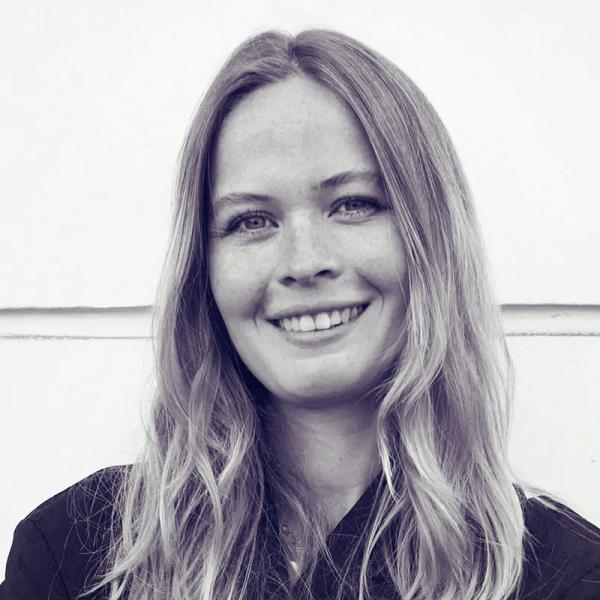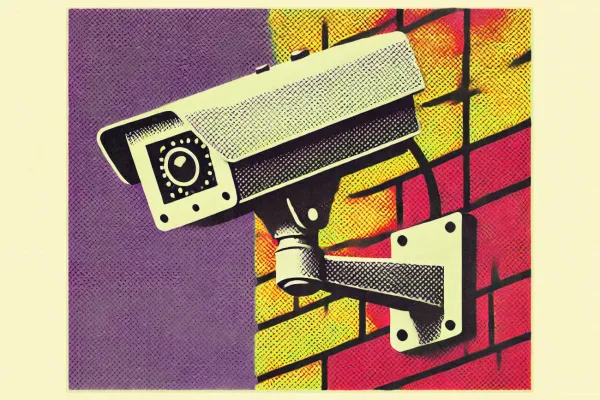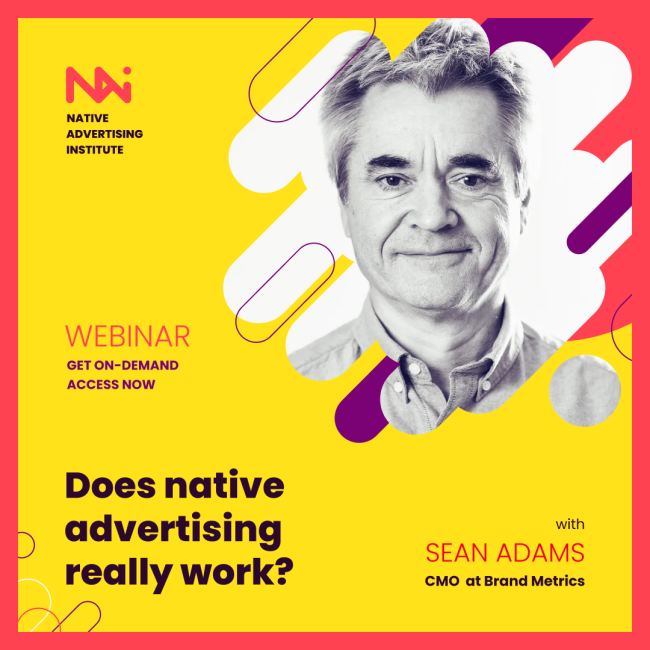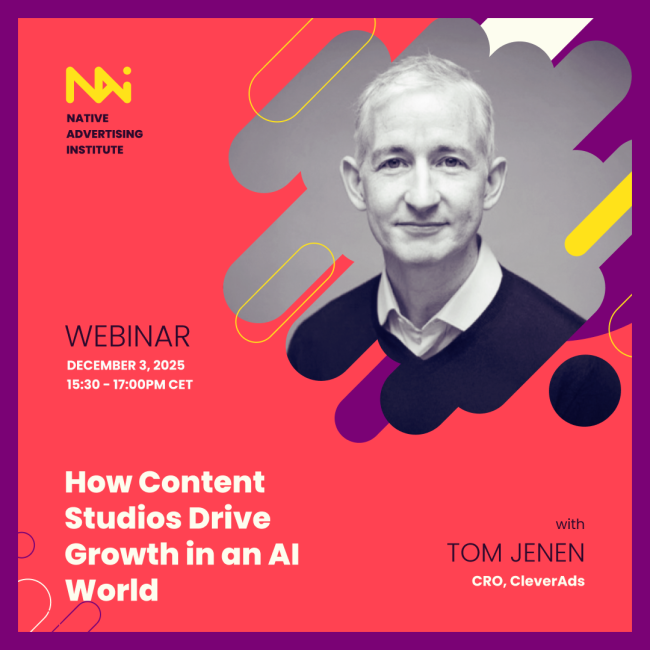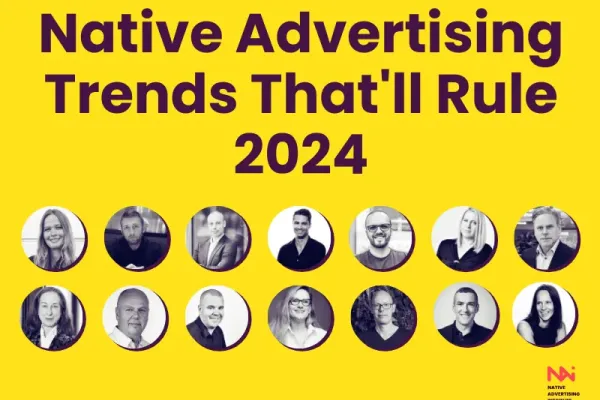
 Details
Details
As 2024 kicks into gear and hopefully reaches higher speeds than 2023, it’s time to ask a collection of industry experts what native advertising trends they see in the coming year.
AI dominated the conversation in 2023, and native advertising experts seem to agree that AI will continue to be a significant trend in native advertising, amongst many other industries. However, there is more to native advertising in 2024 if the experts are to be believed.
Jump into one of the 14 native advertising predictions for 2024 via the table of contents, or read the whole thing from end to end. Please share your reflections by tagging the Native Advertising Institute on LinkedIn. We would love to hear how you think 2024 will turn out.
RELATED: The Best Examples of Native Ads in 2024 So Far
Table of Contents
- Environments to Reach Audiences at a Crucial Time
Keith Gillen, Director at CNN International - Viewability Issues Will Persist as a Challenge
Michael Korsunsky, CEO NA at MGID - Marketers Pivot Back Towards Top-of-Funnel Activities
Helen Anglim, Director at Condé Nast Creative - Brands Will Embrace Courage and Share Their Mission-Driven Storytelling
Joyce Parente, VP, Marketing Solutions at The Guardian US - Trust and Quality as North Star Goals
Tom Michiels, Director at Content Republic at Mediafin - Know the Landscape of Programmatic Native Advertising
Kenneth Landbo, CEO & Co-Founder at weareRELOAD - AI creates an upsurge in content production
Andy Sitta, Head of Seznam Brand Studio - Native Advertising is Finally Growing Up
Erling Tind Larsen, Head of Content at Berlingske Media - AI Will Transform Native Advertising into a Hyper-Personalized Medium
Ana Plisic, Partner, Creative Director at C3 Croatia - 01 Content & Technology - Expanding Horizons and Establishing Guidelines
Stefan Lundstedt, Senior Account Manager and Head of Native at Informa - AI, Purpose and Interaction
Mirta Dabić, Cheif Creative Content Producer at 24sata - AI Will Play a Significant Role
Mats Dicklen, Head of Brand Studio at Bonnier News Brand Studio - Native Advertising in 2024 to Become More Refined and Meticulously Crafted
Ida Kofoed, Head of Storybook - Evolution Towards Purpose-Driven Storytelling
Mads Jungersted, Head of Agency at MOOT
1. Environments to Reach Audiences at a Crucial Time
 Keith Gillen, Director at CNN International
Keith Gillen, Director at CNN International
With 2024 being a significant election year in major countries across the globe, I anticipate an increased focus on the native ad platforms that brands choose for their native activities. Audiences will likely turn even more to reliable sources as they search for truth and accuracy during a time when misinformation is likely to rise. The onus is then on trusted, premium publishers to provide brand-suitable environments where advertisers can reach these audiences at a crucial time. Other significant events in 2024, such as the Olympic Games and Euros, will offer brands multiple opportunities for engagement.
I expect more brands and advertisers to experiment with AI in content creation and distribution, and I'm interested in seeing the value of doing so for both brands and audiences. Brand building will continue to be crucial native advertising trends in 2024, but with ongoing economic challenges, I anticipate that performance, efficient audience targeting, and value will be top of mind for brands, leading to more creativity and innovation. Platforms with high accountability metrics, such as CTV, will benefit and experience continued growth as brands, publishers, and audiences become more familiar with this media and its role in the marketing mix.
READ MORE: 16 Innovative Content Formats That'll Give Your Brand an Edge
2. Viewability Issues Will Persist as a Challenge
 Michael Korsunsky, CEO NA at MGID
Michael Korsunsky, CEO NA at MGID
I'll focus on North America, given my proximity to this market. I don't anticipate any major industry-wide changes to native ads. However, viewability issues will persist as a challenge. Predicting engagement in the programmatic space will also pose difficulties. Content recommendation will become more challenging for platforms in terms of margins as workable supply shrinks, even though overall traffic numbers seem to be increasing. This is because publishers increasingly rely on news/content aggregators (e.g., Newsbreak, SmartNews, etc.), which, for the most part, do not carry over native ad elements across their UX.
Demand-side CPC tolerances will likely remain unchanged on the performance side, and branding will continue to show limited interest in traditional below-fold Native placements due to a lower-than-required visualization rate.
Similar to previous years, the trend is that native will continue to evolve as a "smarter" product in 2024. Video, where possible, will have a robust PnL presence, and search will remain a strong demand vertical.
READ MORE: 4 Examples of Successful Branded Video Content
3. Marketers Pivot Back Towards Top-of-Funnel Activities
 Helen Anglim, Director at Condé Nast Creative
Helen Anglim, Director at Condé Nast Creative
I'm enthusiastic about the branded content trends & opportunities in 2024 as marketers pivot back towards top-of-funnel activities, aiming to forge deeper relationships with consumers. At Condé Nast, we are steadfastly dedicated to sharing our authority in this space. Our strategy revolves around creating meaningful moments and culture for brands. "Culture is the new KPI" serves as our global mantra, and we aspire to enable advertisers to tap into these cultural moments in authentic and meaningful ways.
Research indicates that Gen Z is comfortable with branded content, provided it meets high-quality standards and offers something valuable in exchange for their attention. Gen Z particularly enjoys short-form content, and that's where we intend to connect with them through our highly engaged and expanding social channels. As is the case every year, authenticity and contextually relevant work continue to drive the best engagement and shifts in brand perception. This is one major native advertising trend to continue to watch in 2024.
With the renewed and crucial focus on top-of-funnel marketing, I believe that branded content will stand as a powerful tool for delivering value and making a memorable impact for marketers in 2024.
READ MORE: Want to Advertise to Gen Z? Why Native Advertising Is Your Answer
4. Brands Will Embrace Courage and Share Their Mission-Driven Storytelling
 Joyce Parente, VP, Marketing Solutions at The Guardian US
Joyce Parente, VP, Marketing Solutions at The Guardian US
My native advertising prediction is that brands will embrace courage and share their mission-driven storytelling, refusing to succumb to a culture of silence. Our research highlights that people are discerning; they recognize that profit must go hand-in-hand with purpose. This research also emphasizes their eagerness to learn about positive brand impact for the welfare of others, their communities, and the planet.
READ MORE: What is an Advertorial?
5. Trust and Quality as North Star Goals
 Tom Michiels, Director at Content Republic at Mediafin
Tom Michiels, Director at Content Republic at Mediafin
In a historic election year, where more than half of the global population will participate in voting, the geopolitical climate threatens to become even more uncertain. Companies are beginning to feel the direct impact of climate change, people are facing financial and mental challenges, and the debate over generative AI is set to intensify. In this VUCA (Volatile, Uncertain, Complex, Ambiguous) world, it becomes crucial for native advertising studios to listen attentively to their clients.
Understanding the messages brands wish to convey, their specific goals, the impact they aim to make, and how we, as publishers and native advertising studios, can create sustainable value for all stakeholders is paramount.
To tackle these and various other questions in the most future-proof manner, native advertising studios will need to maintain a crystal-clear focus on trust and quality when collaborating with brands and their agencies to devise creative content solutions. Regardless of the chosen strategy—be it podcast, digital, print, video, or a combination thereof—native storytelling that prioritizes trust and quality as North Star objectives stands the best chance of making a lasting impact in the turbulent yet exciting landscape of 2024.
READ MORE: How the North Star approach can get your native campaigns back on track
6. Know the Landscape of Programmatic Native Advertising
 Kenneth Landbo, CEO & Co-Founder at weareRELOAD
Kenneth Landbo, CEO & Co-Founder at weareRELOAD
One native advertising trend I see in 2024 is that an increasing number of platforms are emerging with a focus on delivering native ads in various forms (in-feed, articles, etc.). Strength in targeting and direct access to inventory/publishers serves as a differentiator and this native ad trend will likely continue in 2024. Demand platforms can offer CPCs comparable to the initial media buy, but KPI performance—from 'dwell-time' to hard CPA goals—varies significantly.
It's not solely about the CPC; the journey from CPC to CTR, bounce rates to conversion, is what truly matters. Transparency is crucial in a cluttered landscape of demand platforms and supply networks. The efficiency of media investments is quickly discerned, and ROI is negatively impacted without it.
READ MORE: Programmatic Native Advertising: 6 Expert Tips
7. AI creates an upsurge in content production
 Andy Sitta, Head of Seznam Brand Studio
Andy Sitta, Head of Seznam Brand Studio
I foresee the rise of AI tools and language models contributing to an upsurge in both general and commercial content production. Tools such as Midjourney/Dall-E may evolve into new sources for stock images. However, this is likely to prompt a quest for higher quality content and a human touch in creation, as people tire of mediocre, repetitive content often lacking factual accuracy.
This native advertising trend might echo what we've observed in the music and film industries: a preference for quality, accessible, and verified content that people are willing to pay for. Brands could adapt by producing less but more impactful content that resonates with their audience, engaging more with influencers and content creators outside the mainstream, and aligning with the content consumption habits of younger generations.
For industry professionals, this shift may initially involve clients substituting copywriters and designers with AI tools like ChatGPT. However, top creators are likely to remain unaffected. Senior professionals might find these tools expedite their work, enabling them to efficiently sift valuable outputs from the less useful. Juniors, on the other hand, may struggle to discern truly high-quality outputs.
In essence, a paradox emerges: while new technologies enable even more personalized ads, the shift away from cookies will strengthen the role of publishers with first-party data, leading to a resurgence in contextual targeting. This aligns well with native advertising, potentially reinforcing its position in the market.
READ MORE: The Types of Native Advertising in 2024
8. Native Advertising is Finally Growing Up
 Erling Tind Larsen, Head of Content at Berlingske Media
Erling Tind Larsen, Head of Content at Berlingske Media
As a commercial genre, native advertising is on the brink of a significant breakthrough. There has been a lengthy build-up, and recent instances of successful native advertising indicate that clients, agencies, and media are poised to take the next step.
When content creators collaborate with advertisers boasting compelling stories and relevant, valuable messages, the outcome is superior content for users. Consequently, we anticipate even tighter integration between media content and advertising material, spanning text, images, video, podcasts, and streaming formats such as news, features, documentaries, whitepapers, and entertainment.
Users will gain access to more high-quality content from commercial sources. Native advertising will generate content that is popular, in demand, and consumed by users—content that becomes the "talk of the town," sparking exciting conversations over the water cooler or by the coffee machine.
This evolution will challenge how we produce native content and impose new requirements on how we label it. No user should doubt that the content is advertiser-paid, but when the content is of exceptional quality, its origin becomes inconsequential.
READ MORE: Visual Ads Masterclass: 8 Essential Visual Techniques for Advertising
9. AI Will Transform Native Advertising into a Hyper-Personalized Medium
 Ana Plisic, Partner, Creative Director at C3 Croatia - 01 Content & Technology
Ana Plisic, Partner, Creative Director at C3 Croatia - 01 Content & Technology
In the ever-evolving landscape of brand communication, 2024 is poised to bring about a paradigm shift in premium native advertising, propelled by advancements in generative AI and large language models (LLMs). Advertisers prioritizing relevance and human-centred communication—addressing user needs rather than merely avoiding interruption—will lead the charge in innovation, engaging audiences in highly personalized, conversational, and dynamic ways.
The long-anticipated transformation is on the horizon. Digital platforms will offer a level of personalization and customization mirroring one-to-one communication, elevating the premium native advertising experience to an unprecedented standard.
With the utilization of Gen-AI, premium native products will not only align with the content and aesthetic of hosting platforms but also resonate deeply with the unique interests and preferences of nearly every user. This hyper-personalization is expected to significantly amplify the impact and effectiveness of premium native ad products. At 01 Content & Technology, as pioneers in applying Gen-AI and LLMs, we are already witnessing this revolution.
The evolution doesn't stop at personalization. Gen-AI will enable predictiveness and proactiveness. By analyzing behavioral trends and historical data, AI can forecast future user interests, empowering brands to craft anticipatory messaging that connects with users' evolving preferences.
In essence, premium native advertising is on the verge of transforming into a proactive, predictive, and hyper-personalized medium. It will evolve into a conversational and immersive experience that is truly native in essence and execution.
READ MORE: The Best Native Ad Spy Tools
10. Expanding Horizons and Establishing Guidelines
 Stefan Lundstedt, Senior Account Manager and Head of Native at Informa
Stefan Lundstedt, Senior Account Manager and Head of Native at Informa
In the ever-evolving realm of digital marketing, my insights foresee a robust future for native advertising, witnessing an increase in innovative formats like podcasts and video. Simultaneously, there is a notable resurgence in traditional channels such as print. This multifaceted evolution signals a need for standardized guidelines to ensure effective and ethical native advertising practices across diverse platforms.
Podcasts, with their engaged audiences, and video, a dominant content medium, offer exciting opportunities for native advertising. Short-form videos on platforms like TikTok and Instagram and niche podcasts provide targeted avenues for brands to integrate their messages seamlessly. However, as these new formats gain prominence, establishing industry-wide standards becomes imperative.
Moreover, the resurgence of native advertising for B2B in traditional channels, such as print, highlights the importance of a comprehensive approach. Magazines and newspapers, adapting to the digital age, present unique opportunities for brands to leverage the credibility and tangibility associated with print media.
In conclusion, as the landscape diversifies, the future of native advertising is expansive and dynamic, encompassing both new and traditional channels. The industry must proactively establish standards to guide the ethical and effective integration of native advertising across diverse platforms, ensuring a harmonious evolution in the digital marketing landscape.
READ MORE: How to Do Native Advertising on Social Media
11. AI, Purpose and Interaction
 Mirta Dabić, Cheif Creative Content Producer at 24sata
Mirta Dabić, Cheif Creative Content Producer at 24sata
The advancement of AI is poised to significantly impact performance, offering more precise targeting and efficient content distribution. Simpler tagging will facilitate the measurement of native advertising performance. While artificial intelligence tools accelerate content research and creation, the intrinsic strength of native lies in tailoring content to the platform and its readers, underscoring the ongoing importance of content creators.
The purposefulness of content is increasingly crucial. Although fun and humor are always advantageous, irrespective of the native topic, there's a growing demand for deeper meaning—whether educational or socially responsible. The content will become less superficial, responding to an audience that seeks stories with a clear purpose.
As the share of mobile advertising expands, so does the demand for new, innovative, and interactive formats. Developing top-quality content is not enough; it is equally vital to present it in a form that encourages reader interaction and engagement in novel ways. This approach ensures the best value for the brand, media, and readers alike.
READ MORE: How To Attract and Convert Mobile Users With Native Advertising
12. AI Will Play a Significant Role
 Mats Dicklen, Head of Brand Studio at Bonnier News Brand Studio
Mats Dicklen, Head of Brand Studio at Bonnier News Brand Studio
I wish I had the answer to what 2024 will mean for us and the Native Ad market. With a consistently weak Swedish currency, shaky inflation, a declining media market, and several concerning wars in our vicinity, predicting 2024 is challenging—almost impossible. However, we can assert that as we exit 2023, native has stood stronger than most other media types, and we observe a trend where companies fortify their brand in these uncertain times, with native proving effective—more than ever. I firmly believe that companies investing in strengthening their brand during such times will emerge stronger in better times, without a doubt.
If we set aside the macro and the larger issues, AI has stepped in, and 2024 promises to be an exciting year where AI will play a significant role in various aspects. AI simply must be one of the most important native advertising trends in 2024, if not in the whole world. We aren't just witnessing efficiency gains; we're seeing the emergence of new products and an increase in quality in many ways. Thus, we wholeheartedly welcome and embrace AI into our family!
With that said, I eagerly anticipate 2024 with positive confidence and rest assured, this content was NOT created by AI. Or was it?
READ MORE: The Role of AI in Native Advertising - and How to Use It Effectively
13. Native Advertising in 2024 to Become More Refined and Meticulously Crafted
In 2023, the advertising industry grappled with economic challenges, leading to a shift towards short-term tactics driven by budget constraints. This often sacrificed authenticity and depth in storytelling. However, as we look ahead to 2024, the narrative is poised to undergo a transformation.
I anticipate native advertising in 2024 to become more refined and meticulously crafted. It's not just about blending with content; it's about enriching it. Expect a fusion of artificial intelligence and human creativity, where AI-driven insights and analytics enhance human capabilities for compelling storytelling and emotional resonance.
The landscape is likely to be more integrated, with native campaigns featuring various creative activations—ranging from influencer collaborations and immersive podcast experiences to inspirational and informative native articles and interactive events. These diverse mediums will converge under the umbrella of coherent, multi-thread narratives, each reinforcing the overall brand story.
Moving forward, the guiding principles at Storybook will be 'Authenticity,' 'Sustainable Engagement,' and 'Integrated Storytelling.' These elements will shape the new era of native advertising, ensuring that campaigns are not only seen and heard but also felt and remembered.
READ MORE: The Top Advantages and Disadvantages of Using Native Advertising
14. Evolution Towards Purpose-Driven Storytelling
 Mads Jungersted, Head of Agency at MOOT
Mads Jungersted, Head of Agency at MOOT
In 2024, native advertising is poised to undergo a remarkable evolution towards purpose-driven storytelling. Brands will increasingly align their narratives with societal values and causes, crafting authentic and emotionally resonant content. Anticipate a shift from overt product-centric ads to narrative-driven storytelling seamlessly woven into the fabric of user experiences.
Furthermore, the ascent of user-generated content (UGC) will redefine native advertising. Brands will collaborate with micro-influencers and content creators, fostering genuine connections with audiences. This trend will underscore authenticity, leveraging real stories and experiences to engage consumers authentically.
In addition, the metaverse will emerge as a new frontier for native advertising. Brands will explore innovative ways to integrate their messages within virtual environments, providing immersive and interactive experiences that blur the lines between advertisement and entertainment. As technology continues to advance, expect AI-powered content generation to facilitate highly personalized native ads, adapting in real-time to individual preferences and behaviours.
Overall, the future of native advertising in 2024 will centre around purposeful storytelling, authentic connections, and the seamless integration of brand messages into immersive experiences across various digital landscapes.
READ MORE: How Much Do Native Ads Cost?
